Aircraft and Automotive Seat Design: Finite Element and CFD Simulation for Static & Dynamic Comfort, Whiplash, Acoustic & Thermal Comfort, Vibration, and Crash Test
The use of Finite Element and CFD Based Design Solution can provide significant benefits for the Seat Design in automotive industry. By using this tool, manufacturers can anticipate manufacturing issues and ensure just-in-time delivery, reducing costs and improving efficiency. The ability to meet regulatory requirements is also a key benefit, as virtual testing can help to ensure compliance with safety standards such as EuroNCAP, JapanNCAP, China C-NCAP, NHTSA (National Highway Traffic Safety Administration) and IIHS (Insurance Institute for Highway Safety).
Finite Element and CFD Based Design can help us to ensure the right occupant posture, which is essential for safety, Static and Dynamic Comfort, for example by predicting the H-Point and incorporating whiplash, thermal and Acoustic comfort simulation. The ability to predict the comfort of innovative seat designs using a combination of advanced design and simulation tools, a library of human models with our team experience in CFD (Siemens Start-ccm+, Ansys Fluent and OpenFoam) and FEA (Ansys LS-DYNA, Simulia Abaqus, ESI Pam-Crash and Altair RADIOSS) simulation software with integrated Artificial Intelligence and Machine Learning for innovative design, can help manufacturers to create seats that provide a superior driving experience for their customers.
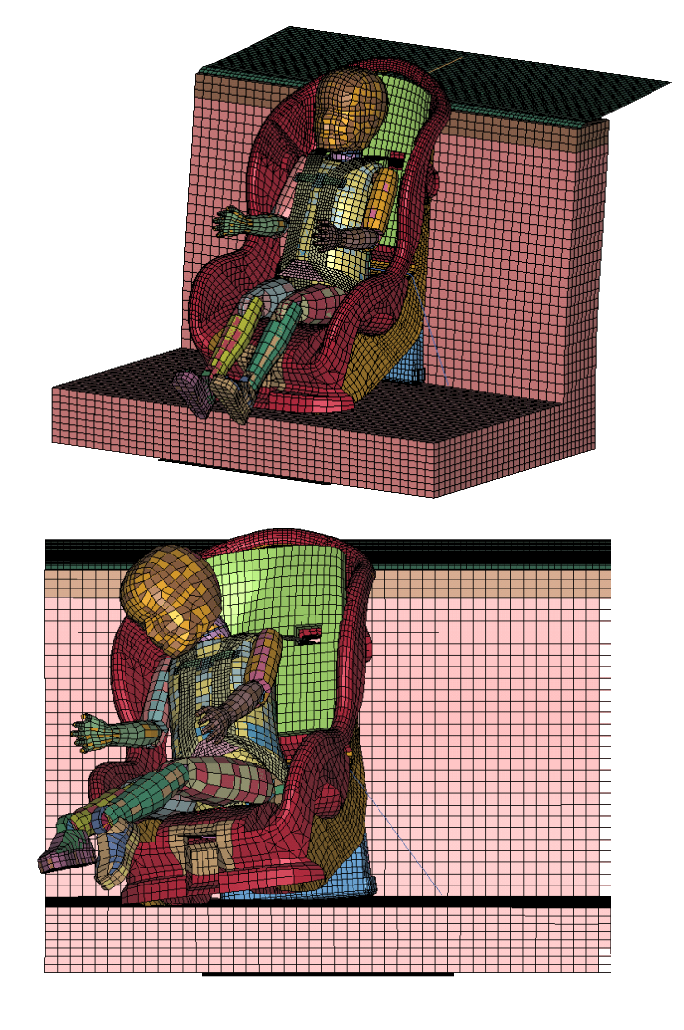
Seat Dynamic Comfort Design
The dynamic comfort design of a car seat is crucial in ensuring the comfort of the occupant and reducing driving fatigue. It involves optimizing the seat’s dynamic characteristics to isolate sensitive vibrations that may cause discomfort and fatigue in the occupant.
The primary source of vibration that affects driving fatigue is the random vibration of the vehicle and the mechanical vibration caused by uneven roads during driving. The driver experiences linear vibrations in the longitudinal, lateral, and vertical directions, as well as angular vibrations in these three directions. Vibration is transmitted to the buttocks and back of the human body through the seat, causing systemic vibration.
To improve dynamic comfort design, the following functions can be taken by using Finite element simulation tools such as Ansys LS-DYNA, Simulia Abaqus, ESI Pam-Crash and Altair RADIOSS:
- Reduce the seat resonance frequency: The resonance frequency of the seat should be minimized to reduce the high-frequency area that is most influential to the human body.
- Reduce vibration transmission rate during resonance: The vibration transmission rate during resonance should be minimized to reduce the impact of resonance below the spring.
- Reduce vibration transmission rate around the occupant at 10 Hz: The vibration transmission rate around the occupant at 10 Hz should be minimized to reduce the influence of resonance and reduce the impact from the seat back high-frequency vibration.
- Consider the road surface-tire, suspension, seat-people as an overall large dynamic system: The car seat should be designed considering the overall system, including the road surface, tire, suspension, and seat-people, to seek the optimal structure that makes the occupants not easy to fatigue under the random input of various road surfaces.
- Optimize dynamic characteristics of the seat: The dynamic characteristics of the seat should be optimized to minimize energy input into the human body, minimize the dynamic response of the human body in the sensitive frequency region, and minimize the root mean square value of the acceleration transmitted to the human body.
The use of high-quality materials with excellent shock-absorbing properties, active vibration control technology, adjusting the seat shape using ergonomic design principles, and considering the psychological factors of the occupant can further enhance the dynamic comfort design of the car seat.
Seat Dynamic comfort Design goal is not only comfortable but also safe. It meets all the federal regulations and crash-safety standards for automotive seats. It also has features that enhance safety, such as side airbags, seat belts with pretensioners and force limiters, and headrests that prevent whiplash injuries. The results of simulation will be reported according to ISO 2631 (Mechanical vibration and shock — Evaluation of human exposure to whole-body vibration).
Meat-to-metal simulation
Meat-to-metal simulation is a method that evaluates the contact between the occupant’s body and the seat structure, taking into account the deformation of the foam and the stiffness of the seat structure. This analysis allows engineers to predict the comfort and durability of the seat, and optimize the design to reduce pressure points and improve overall comfort. Meat-to-metal simulation is particularly useful in the design of high-performance seats, such as those used in sports cars or airplanes, where comfort and support are critical for safety and performance.
When seating the human models, Finite element simulation can evaluates meat-to-metal accurately , including the physical deformation of the seat. This simulation takes into account the deformation of the foam, the foam interaction with the metal frame, and the foam interaction with the occupant’s body. Our engineers can simulate the behavior of the seat and optimize its design for maximum comfort and safety in complicated loading condition.
H-Point measurements
H-Point is an important measurement used in the automotive industry to assess occupant packaging and comfort. It refers to the location of the hip joint of a seated occupant relative to the seat and is commonly used to determine the seat height, cushion length, and other dimensions of the interior of a vehicle.
Finite element simulation software, such as Ansys LS-DYNA, Simulia Abaqus, ESI Pam-Crash and Altair RADIOSS used by our engineers with special purpose dummies to accurately predict H-Point and other posture measurements through dedicated functionalities. These dummies represent a range of occupant sizes and shapes, and their use in virtual simulations helps engineers design seats that can accommodate a wide range of occupants.
International standards like the SAEJ826 (Devices for Use in Defining and Measuring Vehicle Seating Accommodation) are also used in Finite element procedure, allowing our engineers to ensure that their designs meet regulatory requirements and industry standards. These standards provide guidelines for seat dimensions and other key factors that affect occupant comfort and safety.
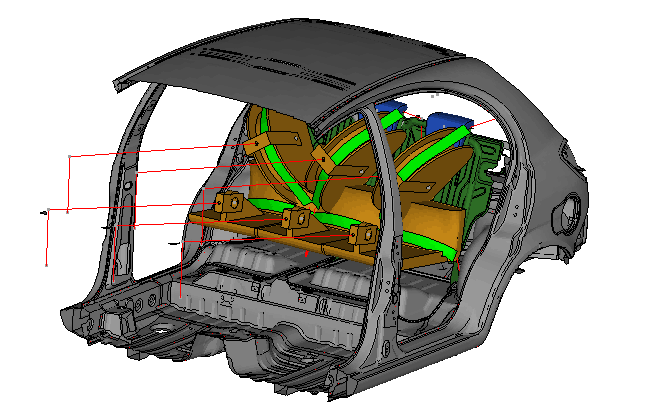

Seat Pressure Mapping
Finite element simulation enables our engineers to analyze the pressure distribution on the seat surface and evaluate the level of comfort using a set of scalable comfort human models. This allows them to compare different seat designs and optimize them for various anthropometries, ensuring that passengers of different sizes and shapes are comfortable during their journey. The pressure mapping analysis can be customized with various comfort criteria, such as pressure distribution, shear stress, and local deformation, providing a comprehensive evaluation of the seat’s comfort performance.
Lumbar support for Car Seat
Lumbar support is an important feature in automotive seating, as it can help reduce lower back pain and fatigue for occupants. Finite element simulation allows our engineers to integrate mechanical or pneumatic lumbar support into virtual seat prototypes and analyze the effects on occupant comfort and posture. Special purpose dummies and human models, can be used to simulate the effects of lumbar support actuation and optimize the system for maximum comfort and effectiveness.
Seat Softness and Hardness Prediction
Our engineering teams finite element simulation dedicated experience allow us to test the softness and hardness of the seat, which can help optimize the design and ensure optimal comfort for passengers. Our process includes international standards, such as SAE J2896 (Motor Vehicle Seat Comfort Performance Measures J2896), to cover all aspect of design and simulation according to international standards . Additionally, our procedure in numerical simulation ensures the accuracy of the prediction through the consistent chaining of stresses and strains coming from the trim manufacturing and assembly process.
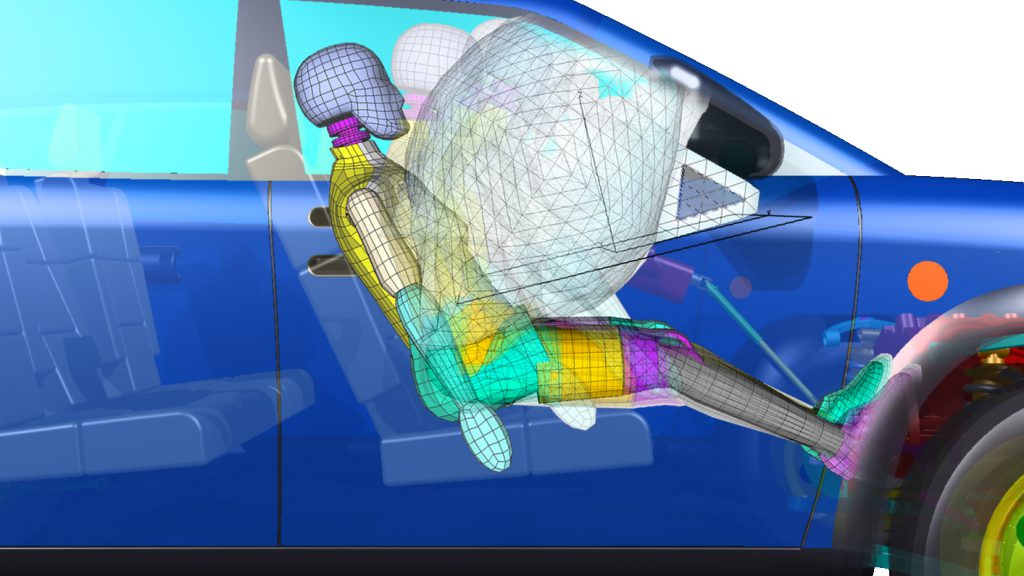
FMVSS 202a: Head Restraints – Methodology and Equipment for the Static and Dynamic Test
In the proposed FMVSS No. 202a, manufacturers were given the option of meeting either of two sets of requirements. The first set was a comprehensive group of dimension and strength requirements, compliance with which is measured statically. The second set was made of requirements that would have to be met in a dynamic test. NHTSA (National Highway Traffic Safety Administration) in FMVSS 202a, Head Restraints, specifies requirements for head restraints to reduce the frequency and severity of neck injury in rear end and other collisions.
The standard applies to each front and rear outboard Designated Seating Position with a head restraint, and allows head restraints to be tested either dynamically or statically. Exceptions are made for school buses; refer to the Code of Federal Regulations for the specific exceptions. This test procedure covers the static requirements. Finite element simulation software, such as Ansys LS-DYNA, Simulia Abaqus, ESI Pam-Crash and Altair RADIOSS used by our engineers with special purpose dummies to simulate head restraints based on FMVSS 202a to reduce the frequency and severity of neck injury in rear end and other collisions.
Other related regulations:
- FMVSS201 Head Impact
- FMVSS207/210 Seatbelt Anchorage
- FMVSS208 Frontal Impact
- FMVSS214 Static & Dynamic Side Impact
- FMVSS225 Child Restraint Anchorage
- FMVSS301 Rear Impact & Fuel Integrity
- Insurance Institute for Highway Safety (IIHS) Offset Frontal Impact
- IIHS Side Impact
- IIHS Low Speed Bumper Impac
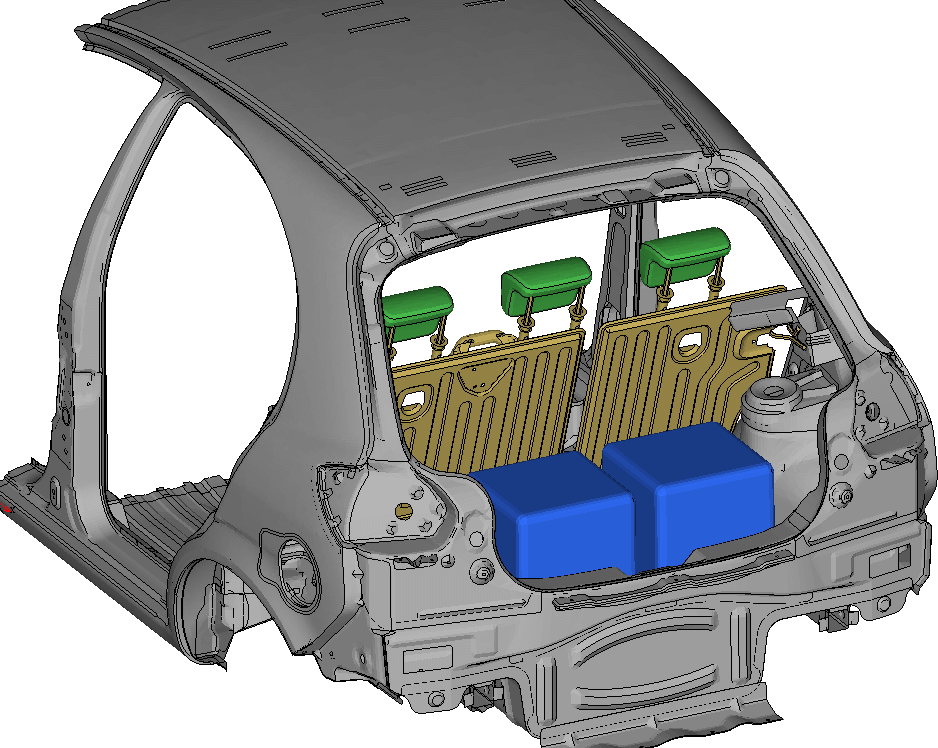

Japan NCAP, Euro NCAP and China NCAP Regulation for Seat Whiplash Assessment
Although whiplash injuries can occur in any kind of crash, an occupant’s chances of sustaining this type of injury are greatest in rear-end collisions. When a vehicle is struck from behind, typically several things occur in quick succession to an occupant of that vehicle. First, from the occupant’s frame of reference, the back of the seat moves forward into his or her torso, straightening the spine and forcing the head to rise vertically. Second, as the seat pushes the occupant’s body forward, the unrestrained head tends to lag behind.
This causes the neck to change shape, first taking on an S-shape and then bending backward. Third, the forces on the neck accelerate the head, which catches up with—and, depending on the seat back stiffness and if the occupant is using a shoulder belt, passes—the restrained torso. This motion of the head and neck, which is like the lash of a whip, gives the resulting neck injuries their popular name. Finite Element simulation with advanced FEA software enable us to simulate seat whiplash with most detailed and accurate procedure to capture real world behavior.
Euro NCAP’s whiplash testing procedure involves a rear-end collision simulation with a crash test dummy sitting in the driver’s seat. The dummy is equipped with sensors that measure the forces exerted on the neck during the crash. The resulting data is used to calculate a Whiplash Injury Criterion (WIC) score, which is used to assess the seat’s performance. Japan NCAP’s whiplash testing procedure is similar to Euro NCAP’s, but it uses a different crash test dummy and has slightly different test conditions. China NCAP’s whiplash testing procedure is also similar to Euro NCAP’s, but it includes additional test conditions to simulate different crash scenarios.
These regulatory testing procedures aim to ensure that automotive seats provide adequate protection against whiplash injuries in the event of a rear-end collision. Finite Element simulation with Ansys LS-DYNA, Simulia Abaqus, ESI Pam-Crash and Altair RADIOSS with special purpose dummies used by our engineers to improve the accuracy of these tests and help optimize the design of seats for better whiplash protection.
Seat Thermal Comfort Design with CFD and FEA (Finite Element) Simulation
Heated and cooled seats are no longer exclusive to luxury cars, as more carmakers offer them for their midrange models. However, designing and optimizing such seats to enhance the occupant’s thermal comfort is a complex process. It involves considering the interactions among the occupant, the seat cover, the cushion foam, and the heating or ventilation systems (air flow), and moisture management, as well as the occupant’s subjective perception of thermal comfort.
One way to address this challenge is to use numerical simulation (Finite element and/or CFD) to simulate the thermal comfort of a driver sitting in a heated or cooled seat. This approach requires digital human models that can capture the human body’s thermal behavior and objective thermal comfort criteria.
Realistic simulations can be performed taking into account aspects such as blood flow, breathing, evaporation, metabolic responses, sweating, shiver, cardiac output and the local heat exchange between the manikin and its interaction between seat and environment. Our Finite Element (Ansys LS-Dyna, Abaqus, Pam-Crash and RADIOSS ) and CFD simulation (Siemens Start-ccm+, Ansys Fluent and OpenFoam) for Seat design and virtual test process can save time and money in the design and development process, while also improving the thermal comfort and overall quality of the final product.
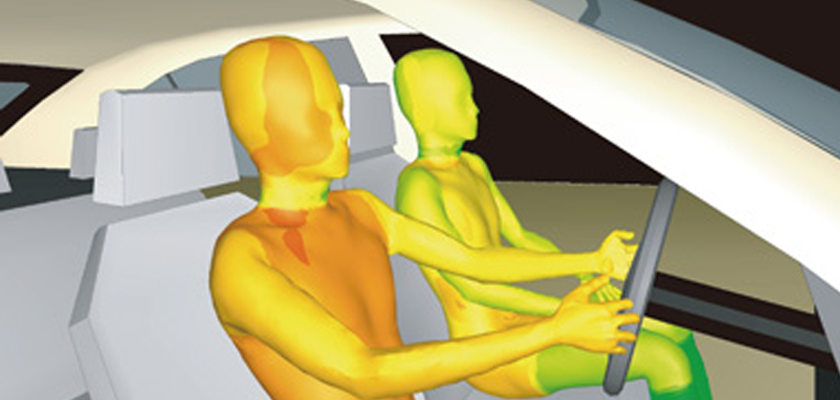
Aerospace Seat Design: Federal Aviation Administration (FAA) and European Aviation Safety Agency (EASA)
In the United States, the Federal Aviation Administration (FAA) sets the standards for aerospace seat design regulations through its Technical Standard Orders (TSOs) and Federal Aviation Regulations (FARs). By using FEA according to FAA, our engineers can simulate the structural behavior of an aircraft seat and predict its response to various loading scenarios, including vibration , fatigue life, crash and impact conditions.
In Europe, the regulations governing aerospace seats are defined by the European Aviation Safety Agency (EASA). These regulations are contained in the Certification Specifications for Large Aeroplanes CS-25, Amendment 16, which outlines the airworthiness standards that must be met for certification of large airplanes, including the design and testing of aircraft seats. The EASA regulations require that aerospace seats are designed to ensure the safety and comfort of passengers during all phases of flight. This includes requirements for seat strength and durability, flammability, crashworthiness, and emergency evacuation.

- Simulation based design can be used to evaluate compliance with specific aerospace seat design regulations related to crashworthiness, such as the strength and durability of the seat frame, attachment points, and materials used in construction. For example, FEA can be used to simulate crash landing scenarios and analyze the seat’s ability to absorb and dissipate crash forces, as well as its ability to protect passengers from injury. The FAA has established standards for the structural integrity of seats, including the strength and durability of the seat frame, the attachment points to the aircraft structure, and the ability of the seat to absorb and dissipate crash forces.
- FEA can also be used to optimize the design of aerospace seats to meet specific safety standards and regulations. By simulating different design configurations, engineers can identify the most effective design for meeting safety standards while also optimizing for other factors such as weight, cost, and passenger comfort.
- Simulation based design can be used to evaluate the performance of individual components of an aerospace seat, such as seat belts and restraint systems. The FAA requires that all aircraft seats be equipped with a seat belt or restraint system that meets specific standards for strength, durability, and ease of use. These regulations ensure that passengers can be safely secured in their seats during takeoff, landing, and turbulence.
- Vibration is also a critical design consideration for aerospace seats, as excessive vibration can lead to discomfort and fatigue for passengers. By simulating the dynamic response of the seat, our engineers can identify areas of the seat that are subject to excessive vibration and modify the seat design to reduce these vibrations. This can involve adjusting the geometry of the seat, modifying the damping characteristics of the seat structure, or using vibration-absorbing materials in the seat construction.
- Finite element simulation can be used to simulate the cyclic loading conditions that aerospace seats are subject to, and predict the potential for fatigue failure. By using FEA, engineers can simulate the structural behavior of an aerospace seat over time, considering factors such as cyclic loading, material fatigue properties, and stress concentrations.
- Finite Element can be used in military seat design procedure for aircraft survival in crash, considering technical guides from defense organizations such as: Aircraft Crash Survival Design Guide: Aircraft Seats, Restraints, Litters and Cockpit/Cabin Delethalization

Dummies for crash Test Simulation:
- Frontal impact dummies
- Hybrid II (50th percentile) rigid dummy for aeronautics applications
- Express Hybrid III 50th, & 5th percentile dummies
- Hybrid III 50th, 95th & 5th percentile dummies
- Side impact dummies:
- ES2 & ES2-re
- FTSS SID-IIs SBL C & D
- US SID
- SIDHIII
- WorldSID 50%
- WorldSID 5%
- Rear impact dummy
- BIORID IIg
- Child dummies
- Hybrid III 6 years
- Hybrid III 10 years
- P series 3, 6 and 10 years, 18 months
- Q series 3 years
- CRABI 12 months
- Pedestrian impactors
- Head (EEVC adults and Child, FMVSS 201)
- Pedestrian Head forms EEVC
- Lower leg EEVC impactor
- Upper leg EEVC impactor
- Standing HIII 50th rigid dummy
- Standing HIII child 6 years rigid dummy
- Human dummy model
- Complete human model: Humos2
- Human head, leg and foot models
- Barriers :
- Frontal barriers
- ODB (ECE 94 frontal regulation) solid & shell models
- PDB V8XT proposed by EEVC WG 15 for crash impact compatibility – shell & solid models
- TRL full width (consumer information test NCAP) – shell & solid models
- Side barriers
- NHTSA FMVSS 214 – solid & shell models
- Progress ECE 95– solid & shell models (Cellbond)
- AEMDB V3.9 = new proposal to update regulation EEVC W13 – solid & shell models (Cellbond)
- IIHS SUV Barrier – solid & shell models (Cellbond)
- Rear barriers
- RCAR IIHS low impact
- US Rear impact barrier FMVSS 310
- Rear impact ECE barrier
Head injury criterion
The head injury criterion (HIC) is a mathematical formula that uses acceleration data to estimate the potential for head injury during an impact event. The HIC is commonly used in the automotive industry to evaluate the safety of vehicles, but it can also be applied to other products like personal protective gear and sports equipment.
The NHTSA and Insurance Institute for Highway Safety both use the HIC to evaluate the safety of vehicles and assign safety ratings. The NHTSA uses the HIC to determine the star rating for automobile safety, with a lower HIC value indicating a lower risk of head injury. The Insurance Institute for Highway Safety uses the HIC as one of several criteria to determine the safety ratings of vehicles, including the Top Safety Pick and Top Safety Pick+ awards. The maximum allowed HIC value of 700 under the U.S. advanced airbag regulation reflects the importance of limiting head injury risk in automotive crashes.
It’s worth noting that the HIC is just one of several metrics used to assess head injury risk, and it has some limitations. For example, it does not account for the rotational forces that can contribute to traumatic brain injuries. Nonetheless, the HIC remains a useful tool for evaluating the safety of various products and promoting the design of safer products.
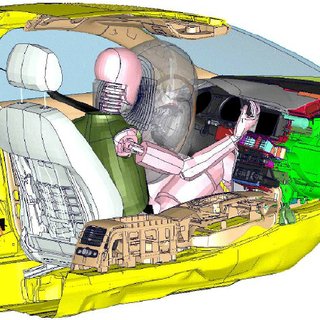
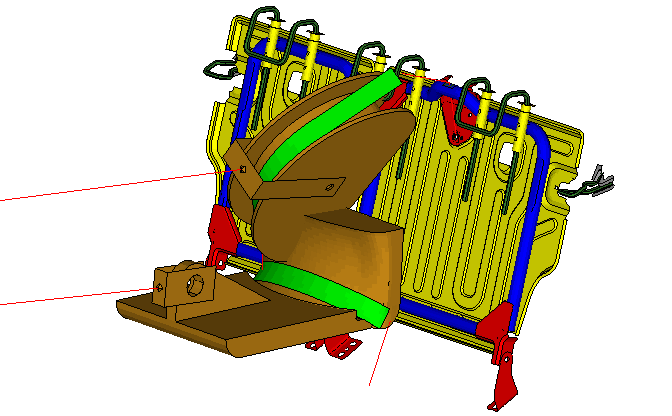
WE WORK WITH YOU
We pride ourselves on empowering each client to overcome the challenges of their most demanding projects.
Enteknograte offers a Virtual Engineering approach with FEA tools such as MSC Nastran, MSC Actran , ABAQUS, Ansys, and LS-Dyna, and CFD tools such as Siemens Star-ccm+ , Ansys Fluent and MSC Cradle encompassing the accurate prediction of in-service loads, the performance evaluation, and the integrity assessment including the influence of manufacturing the components.
Crash Test and Crashworthiness
eVTOL (Electric Vertical Take-Off and Landing) & UAM (Urban Air Mobility)
NVH & Acoustics for Hybrid & Electric Vehicles
Full Vehicle MultiBody Dynamics Simulation: Car Ride, Driveline, Engine and Tire MBD
Acoustics and Vibration: FEA and CFD for AeroAcoustics, VibroAcoustics and NVH Analysis
Aerodynamics Simulation: Coupling CFD with MBD, FEA and 1D-System Simulation
Integrated Artificial Intelligence (AI) & Machine Learning - Deep Learning with CFD & FEA Simulation
FEA Based Composite Material Design and Optimization: MSC Marc, Abaqus, Ansys, Digimat and LS-DYNA
Finite Element Analysis of Durability and Fatigue Life
Heat Transfer and Thermal Analysis: Fluid-Structure Interaction with Coupled CFD and Finite Element Based Simulation
In Silico Medical & Biomedical Device Testing: Finite Element & CFD Simulation and Design, Considering FDA & ASME V&V 40
Additive Manufacturing and 3D Printing




